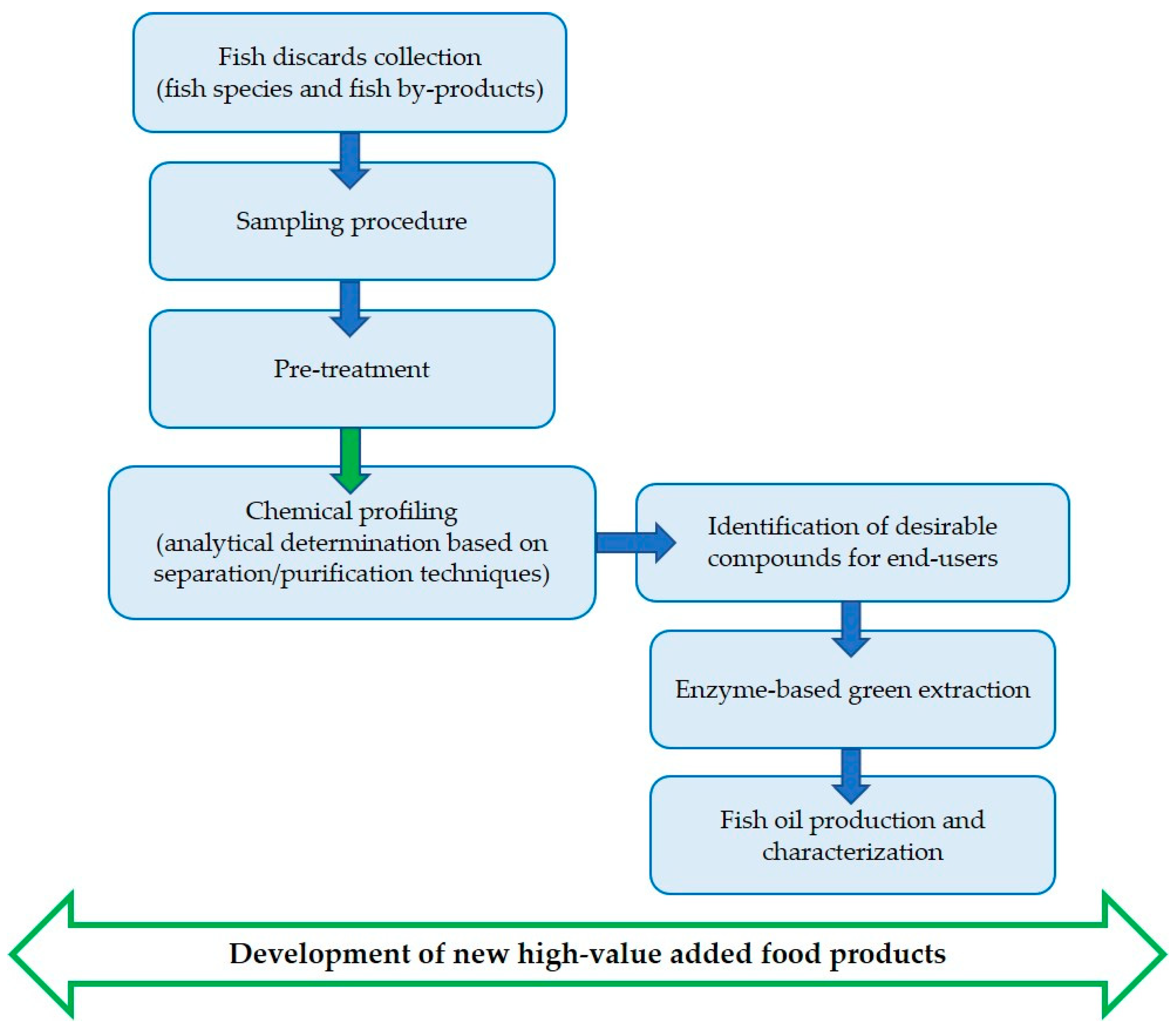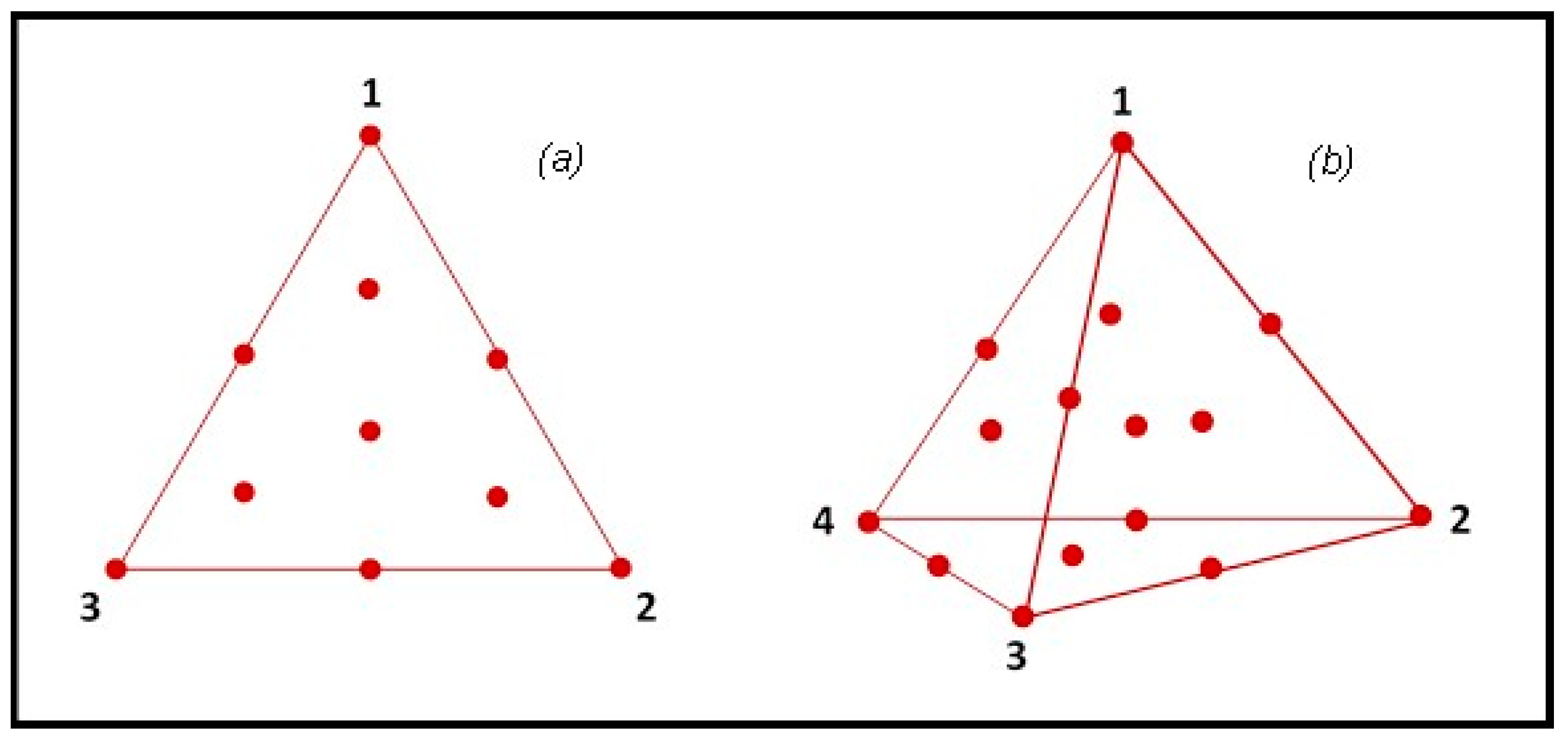Sustainable Management of Secondary Raw Materials from the Marine Food-Chain: A Case-Study Perspective
Abstract
1. Introduction
2. The Context: Recent Trends and Prospects
2.1. Aim of the PROBIS Project
2.2. Characterization and Exploitation of By-Products from the Marine Food Chain: Methodologies
3. Conclusions
Author Contributions
Funding
Conflicts of Interest
References
- Premanandh, J. Factors affecting food security and contribution of modern technologies in food sustainability. J. Sci. Food Agric. 2011, 91, 2707–2714. [Google Scholar] [CrossRef] [PubMed]
- Gustavsson, J.; Cederberg, C.; Sonesson, U. Global Food Losses and Food Waste—Extent, Causes and Prevention; Food and Agriculture Organization of the United Nations: Rome, Italy, 2011; Available online: http://www.fao.org/docrep/014/mb060e/mb060e00.pdf (accessed on 28 August 2020).
- Food and Agriculture Organization of the United Nations. The State of World Fisheries and Aquaculture. 2018. Available online: http://www.fao.org/3/i9540en/I9540EN.pdf (accessed on 28 August 2020).
- European Market Observatory for Fisheries and Aquaculture Products. The EU Fish Market; Edition Luxembourg; Publications Office of the European Union: Luxembourg, 2019. [Google Scholar] [CrossRef]
- Nawaz, A.; Li, E.; Irshad, S.; Xiong, Z.; Xiong, H.; Shahbaz, H.M.; Siddique, F. Valorization of fisheries by-products: Challenges and technical concerns to food industry. Trends Food Sci. Technol. 2020, 99, 34–43. [Google Scholar] [CrossRef]
- Ashraf, S.A.; Adnan, M.; Patel, M.; Siddiqui, A.J.; Sachidanandan, M.; Snoussi, M.; Hadi, S. Fish-Based Bioactives as Potent Nutraceuticals: Exploring the Therapeutic Perspective of Sustainable Food from the Sea. Mar. Drugs 2020, 18, 265. [Google Scholar] [CrossRef] [PubMed]
- Buchspies, B.; Tölle, S.J.; Jungbluth, N. Life Cycle Assessment of High-Sea Fish and Salmon Aquaculture; ESU-services Ltd.: Schaffhausen, Switzerland, 2011; p. 26. [Google Scholar]
- European Commission. 2020 Blue Economy Report: Blue Sectors Contribute to the Recovery and Pave Way for EU Green Deal; European Commission: Brussels, Belgium, 2020. [Google Scholar]
- Vandermeersch, T.; Alvarenga, R.A.F.; Ragaert, P.; Dewulf, J. Environmental sustainability assessment of food valorization options. Res. Cons. Rec. 2014, 87, 57–64. [Google Scholar] [CrossRef]
- Wunderlich, S.M.; Martinez, N.M. Conserving natural resources through food loss reduction: Production and consumption of the food supply chain. Int. Soil Water Cons. Res. 2018, 6, 331–339. [Google Scholar] [CrossRef]
- Ecocerved. Industria Alimentare e Rifiuti: Anni 2008–2011; Ecocerved: Padova, Italy, 2013. [Google Scholar]
- Kim, S.K.; Mendis, E. Bioactive compounds from marine processing byproducts—A review. Food Res. Int. 2006, 39, 383–393. [Google Scholar] [CrossRef]
- Arvanitoyannis, I.S.; Kassaveti, A. Fish industry waste: Treatments, environmental impacts, current and potential uses. Int. J. Food Sci. Technol. 2008, 43, 726–745. [Google Scholar] [CrossRef]
- Villamil, O.; Vaquiro, H.; Solanilla, J.F. Fish viscera protein hydrolysates: Production, potential applications and functional and bioactive properties. Food Chem. 2017, 224, 160–171. [Google Scholar] [CrossRef]
- Zamora-Sillero, J.; Gharsallaoui, A.; Prentice, C. Peptides from Fish by-product Protein Hydrolysates and Its Functional Properties: An Overview. Mar. Biotechnol. 2018, 20, 118–130. [Google Scholar] [CrossRef]
- Kris-Etherton, P.M.; Harris, W.S.; Appel, L.J. Fish consumption, fish oil, Omega-3 fatty acids and cardiovascular disease. Circulation 2002, 106, 2747–2757. [Google Scholar] [CrossRef]
- Lavie, C.J.; Milani, R.V.; Mehra, M.R.; Ventura, H.O. Omega-3 polyunsaturated fatty acids and cardiovascular diseases. J. Am. Coll. Cardiol. 2009, 54, 585–594. [Google Scholar] [CrossRef] [PubMed]
- Chrysohoou, C.; Panagiotakos, D.B.; Pitsavos, C.; Skoumas, J.; Krinos, X.; Yannis, C.; Vassilios, N.; Stefanadis, C. Long-term fish consumption is associated with protection against arrhythmia in healthy persons in a Mediterranean region—The ATTICA study. Am. J. Clin. Nutr. 2007, 85, 1385–1391. [Google Scholar] [CrossRef]
- Swanson, D.; Block, R.; Mousa, S.A. Omega-3 fatty Acids EPA and DHA: Health benefits throughout life. Adv. Nutr. 2012, 3, 1–7. [Google Scholar] [CrossRef] [PubMed]
- Innis, S.M. Dietary omega 3 fatty acids and the developing brain. Brain Res. 2008, 1237, 35–43. [Google Scholar] [CrossRef] [PubMed]
- Querques, G.; Forte, R.; Souied, E.H. Retina and Omega-3. J. Nutr. Metab. 2011, 2011, 748361. [Google Scholar] [CrossRef] [PubMed]
- Derbyshire, E. Brain health across the lifespan: A systematic review on the role of omega-3 fatty acid supplements. Nutrients 2018, 10, 1094. [Google Scholar] [CrossRef] [PubMed]
- Huang, T.L. Omega-3 fatty acids, cognitive decline and Alzheimer’s disease: A critical review and evaluation of the literature. J. Alzheimer Dis. 2010, 21, 673–690. [Google Scholar] [CrossRef]
- Kris-Etherton, P.M.; Harris, W.S.; Appel, L.J. Omega-3 fatty acids and cardiovascular diseases: New reccomandations from the American Heart Association. Arterioscler. Thromb. Vasc. Biol. 2003, 23, 99–196. [Google Scholar] [CrossRef] [PubMed]
- Harris, W.S.; Poston, W.C.; Haddock, C.K. Tissue n-3 and n-6 fatty acids and risk for coronary heart disease events. Atherosclerosis 2007, 193, 1–10. [Google Scholar] [CrossRef]
- GISSI-HF Investigators. Effect of n-3 polyunsaturated fatty acids in patients with chronic heart failure (the GISSI-HF trial): A randomised, double-blind, placebo-controlled trial. Lancet 2008, 372, 1223–1230. [Google Scholar] [CrossRef]
- Abdelhamid, A.S.; Brown, T.J.; Brainard, J.S.; Biswas, P.; Thorpe, G.C.; Moore, H.J.; Deane, K.H.; AlAbdulghafoor, F.K.; Summerbell, C.D.; Worthington, H.V.; et al. Omega-3 fatty acids for the primary and secondary prevention of cardiovascular disease. Cochrane Database Syst. Rev. 2018. [Google Scholar] [CrossRef]
- Poudyal, H.; Panchal, S.K.; Diwan, V.; Brown, L. Omega-3 fatty acids and metabolic syndrome: Effects and emerging mechanisms of action. Prog. Lipid Res. 2011, 50, 372–387. [Google Scholar] [CrossRef]
- EFSA Panel on Dietetic Products, Nutrition and Allergies (NDA). Scientific Opinion related to the Tolerable Upper Intake Level of eicosapentaenoic acid (EPA), docosahexaenoic acid (DHA) and docosapentaenoic acid (DPA). EFSA J. 2012, 10, 2815. Available online: https://efsa.onlinelibrary.wiley.com/doi/10.2903/j.efsa.2012.2815 (accessed on 28 August 2020). [CrossRef]
- Galanakis, C.M.; Patsioura, A.; Gekas, V. Enzyme kinetics modeling as a tool to optimize food biotechnology applications: A pragmatic approach based on amylolytic enzymes. Crit. Rev. Food Sci. Technol. 2015, 55, 1758–1770. [Google Scholar] [CrossRef]
- Kato, S.; Kunisawa, N.; Kojima, T.; Murakami, S. Evaluation of ozone treated fish waste oil as a fuel for transportation. J. Chem. Eng. Jpn. 2004, 37, 863–870. [Google Scholar] [CrossRef]
- Monroig, O.; Tocher, D.R.; Castro, L.F. Polyunsaturated fatty acid biosynthesis and metabolism in fish. In Polyunsaturated Fatty Acid Metabolism; Burdge, G.C., Ed.; Academic Press: Cambridge, MA, USA; AOCS: Urbana, IL, USA, 2018; pp. 31–60. [Google Scholar]
- Fiori, L.; Volpe, M.; Lucian, M.; Anesi, A.; Manfrini, M.; Guella, G. From Fish Waste to Omega-3 Concentrates in a Biorefinery Concept. Waste Biomass Valor. 2017, 8, 2609–2620. [Google Scholar] [CrossRef]
- Babajafari, S.; Moosavi-Nasab, M.; Nasrpour, S.; Golmakani, M.T.; Nikaein, F. Comparison of enzymatic hydrolysis and chemical methods for oil extraction from rainbow trout (Oncorhynchus mykiss) waste and its influence onomega 3 fatty acid profile. Int. J. Nutr. Sci. 2017, 2, 58–65. [Google Scholar]
- Iberahim, N.I.; Hamzah, Z.; Yin, Y.J.; Sohaimi, K.S.A. Extraction and characterization of Omega-3 fatty acid from catfish using enzymatic hydrolysis technique. MATEC Web Conf. 2018, 187, 01005. [Google Scholar] [CrossRef][Green Version]
- Kralovec, J.A.; Zhang, S.C.; Zhan, W.; Barrow, C.J. A review of the progress in enzymatic concentration and microencapsulation of omega-3 rich oil from fish and microbial sources. Food Chem. 2012, 131, 639–644. [Google Scholar] [CrossRef]
- Zuorro, A.; Malavasi, V.; Cao, G.; Lavecchia, R. Use of cell wall degrading enzymes to improve the recovery of lipids from Chlorella sorokiniana. Chem. Eng. J. 2019, 377, 120325. [Google Scholar] [CrossRef]
- Levine, S.E.; Fox, J.M.; Clark, D.S.; Blanch, H.W. A mechanistic model for rational design of optimal cellulase mixtures. Biotechnol. Bioeng. 2011, 108, 2561–2570. [Google Scholar] [CrossRef]
- Zuorro, A. Enhanced lycopene extraction from tomato peels by optimized mixed-polarity solvent mixtures. Molecules 2020, 25, 2038. [Google Scholar] [CrossRef]
- Montgomery, D.C. Design and Analysis of Experiments, 8th ed.; John Wiley & Sons: New York, NY, USA, 2012; pp. 530–539. [Google Scholar]
- Luzi, F.; Puglia, D.; Sarasini, F.; Tirillò, J.; Maffei, G.; Zuorro, A.; Lavecchia, R.; Kenny, J.M.; Torre, L. Valorization and extraction of cellulose nanocrystals from North African grass: Ampelodesmos mauritanicus (Diss). Carbohydr. Polym. 2019, 209, 328–337. [Google Scholar] [CrossRef]
- Maffei, G.; Bracciale, M.P.; Broggi, A.; Zuorro, A.; Santarelli, M.L.; Lavecchia, R. Effect of an enzymatic treatment with cellulase and mannanase on the structural properties of Nannochloropsis microalgae. Bioresour. Technol. 2018, 249, 592–598. [Google Scholar] [CrossRef]
- Vongsvivut, J.; Heraud, P.; Zhang, W.; Kralovec, J.A.; McNaughton, D.; Barrow, C.J. Quantitative determination of fatty acid compositions in micro-encapsulated fish-oil supplements using Fourier transform infrared (FTIR) spectroscopy. Food Chem. 2012, 135, 603–609. [Google Scholar] [CrossRef] [PubMed]
- Granato, D.; de Araứjo, V.M.; Jarvis, B. Observations on the use of statistical methods in Food Science and Technology. Food Res. Int. 2014, 55, 137–149. [Google Scholar] [CrossRef]
- Lucarini, M.; Durazzo, A.; Sanchez del Pulgar, J.; Gabrielli, P.; Lombardi-Bocia, G. Determination of fatty acid content in meat and meat products: The FTIR-ATR approach. Food Chem. 2017. [Google Scholar] [CrossRef]
- Bligh, E.G.; Dyer, W.J. A rapid method of total lipid extraction and purification. Can. J. Biochem. Physiol. 1959, 37, 911–917. [Google Scholar] [CrossRef] [PubMed]
- Metcalfe, L.D.; Schmitz, A.A. The rapid preparation of fatty acid esters for gas chromatographic analysis. Anal. Chem. 1961, 33, 363–364. [Google Scholar] [CrossRef]
- Lima, R.M.F.; Brandao, P.R.G.; Peres, A.E.C. The infrared spectra of amine collectors used in the flotation of iron ores. Miner. Eng. 2005, 18, 267–273. [Google Scholar] [CrossRef]
- Bellamy, L.J. The Infrared Spectra of Complex Molecules; Wiley: New York, NY, USA, 1975. [Google Scholar]
- Cao, Q.B.; Cheng, J.H.; Wen, S.M.; Li, C.X.; Bai, S.J.; Liu, D. A mixed collector system for phosphate flotation. Miner. Eng. 2015, 78, 114–121. [Google Scholar] [CrossRef]
- Silva, S.D.; Rosa, N.F.; Ferreira, A.E.; Boas, L.V.; Bronze, M.R. Rapid Determination of Alpha-Tocopherol in Vegetable Oils by Fourier Transform Infrared Spectroscopy. Food Anal. Meth. 2009, 2, 120–127. [Google Scholar] [CrossRef]
- Man, Y.B.C.; Ammawath, W.; Mirghani, M.E.S. Analytical, nutritional and clinical methods: Determining α-tocopherol in refined bleached and deodorized palm olein by Fourier transform infrared spectroscopy. Food Chem. 2005, 90, 323–327. [Google Scholar] [CrossRef]
- D’Evoli, L.; Tufi, S.; Gabrielli, P.; Lucarini, M.; Lombardi-Boccia, G. Analisi simultanea della vitamina E in campioni alimentari tramite cromatografia liquida-spettrometria di massa. J. Food Sci. Nutr. 2013, 3, 33–39. [Google Scholar]




| Enzyme | Biological Source |
|---|---|
| Bromelain | Pineapple stem |
| Ficin | Fig tree latex |
| Papain | Papaya latex |
| Papain | Carica papaya |
| Pepsin | Porcine gastric mucosa |
| Trypsin | Porcine pancreas |
| Protease | Rhizopus sp. |
| Protease | Bovine pancreas |
Publisher’s Note: MDPI stays neutral with regard to jurisdictional claims in published maps and institutional affiliations. |
© 2020 by the authors. Licensee MDPI, Basel, Switzerland. This article is an open access article distributed under the terms and conditions of the Creative Commons Attribution (CC BY) license (http://creativecommons.org/licenses/by/4.0/).
Share and Cite
Lucarini, M.; Zuorro, A.; Di Lena, G.; Lavecchia, R.; Durazzo, A.; Benedetti, B.; Lombardi-Boccia, G. Sustainable Management of Secondary Raw Materials from the Marine Food-Chain: A Case-Study Perspective. Sustainability 2020, 12, 8997. https://doi.org/10.3390/su12218997
Lucarini M, Zuorro A, Di Lena G, Lavecchia R, Durazzo A, Benedetti B, Lombardi-Boccia G. Sustainable Management of Secondary Raw Materials from the Marine Food-Chain: A Case-Study Perspective. Sustainability. 2020; 12(21):8997. https://doi.org/10.3390/su12218997
Chicago/Turabian StyleLucarini, Massimo, Antonio Zuorro, Gabriella Di Lena, Roberto Lavecchia, Alessandra Durazzo, Barbara Benedetti, and Ginevra Lombardi-Boccia. 2020. "Sustainable Management of Secondary Raw Materials from the Marine Food-Chain: A Case-Study Perspective" Sustainability 12, no. 21: 8997. https://doi.org/10.3390/su12218997
APA StyleLucarini, M., Zuorro, A., Di Lena, G., Lavecchia, R., Durazzo, A., Benedetti, B., & Lombardi-Boccia, G. (2020). Sustainable Management of Secondary Raw Materials from the Marine Food-Chain: A Case-Study Perspective. Sustainability, 12(21), 8997. https://doi.org/10.3390/su12218997








